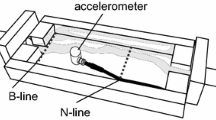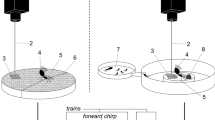Abstract
Many bee species produce thoracic vibrations in various contexts. Among the social stingless bees (Meliponini) pulsed thoracic vibrations are used to communicate with nestmates. To date all studies on stingless bee vibrational communication have been conducted in the Neotropics. We, therefore, focused on six African stingless bee species of five genera: Meliponula, Hypotrigona, Liotrigona, Dactylurina, Plebeina. We analysed the signals’ temporal patterns. Vibrational signals appear to play a role in the recruitment of stingless bees. The degree of signal variation in the studied species was much lower than the variation in the signals of Neotropical stingless bees. Furthermore, the inter-signal variation of the temporal patterns exceeded intra-signal variation. This might reveal that the bees are able to modulate the temporal patterns and the signals potential communicative value. Furthermore, foraging activity correlates with pulse production in H. gribodoi and M. bocandei, supporting the hypothesis that the vibrational signals are used in the context of foraging and recruitment.




Similar content being viewed by others
References
Aguilar I, Briceño D (2002) Sounds in Melipona costaricensis (Apidae: Meliponini): effect of sugar concentration and nectar source distance. Apidologie 33:375–388. doi:10.1051/apido:2002023
Baroni-Urbani C, Buser MW, Schilliger E (1988) Substrate vibration during recruitment in ant social organisation. Insect Soc 35:241–250. doi:10.1007/BF02224057
Barth FG, Hrncir M, Jarau S (2008) Signals and cues in the recruitment behaviour of stingless bees. J Comp Physiol 194:313–327. doi:10.1007/s00359-008-0321-7
Cao TT, Hyland KM, Malechuk A, Lewis LA, Schneider SS (2007) The influence of the vibration signal on worker interactions with the nest and nest mates in established and newly founded colonies in honey bee, Apis mellifera. Insect Soc 54:144–149. doi:10.1007/a00040-007-0921-1
Cocroft RB, Rodríguez RL (2005) The behavioral ecology of insect vibrational communication. Bioscience 55:323–334. doi:10.1641/0006-3568(2005)055[0323:TBEOIV]2.0.CO;2
Cocroft RB, Gogala M, Hill PSM, Wessel A (2014) Fostering research progress in a rapidly growing field. In: Cocroft RB, Gogala M, Hill PSM, Wessel A (eds) Studying vibrational communication. Springer, Berlin, pp 3–12
Darchen R (1972) Écologie de quelques Trigones (Trigona sp.) de la savane de Lamto (Cote D’Ivoire). Apidologie 3:341–367
Dyer FC (2002) The biology of the dance language. Annu Rev Entomol 47:917–949. doi:10.1146/annurev.ento.47.091201.145306
Eardley C (2004) Taxonomic revision of the African stingless bees (Apoidea: Apidae: Apinae: Meliponini). Afr Plant Prot 10:63–96
Eckles MA, Roubik DW, Nieh JC (2012) A stingless bee can use visual odometry to estimate both height and distance. J Exp Biol 215:3155–3160. doi:10.1242/jeb.070540
Endler JA (2014) Foreword. In: Cocroft RB, Gogala M, Hill PSM, Wessel A (eds) Studying vibrational communication. Springer, Berlin, pp ix–x
Esch H (1961) Über die Schallerzeugung beim Werbetanz der Honigbiene. Z vergl Physiol 45:1–11
Esch H (1967) Die Bedeutung der Lauterzeugung für die Verständigung der stachellosen Bienen. Z vergl Physiol 56:199–220
Esch H, Esch I, Kerr WE (1965) Sound: an element common to communication of stingless bees and to dances of the honey bee. Science 149:320–321
Evans TA, Lai JCS, Toledano E, McDowall L, Rakotonarivo S, Lenz M (2005) Termites assess wood size by using vibration signals. PNAS 102:3732–3737. doi:10.1073/pnas.0408649102
Evans TA, Inta R, Lai JCS, Lenz M (2007) Foraging vibration signals attract foragers and identify food size in the drywood termite, Cryptotermes secundus. Insect Soc 54:374–382. doi:10.1007/s00040-007-0958-1
Golden TMJ, Hill PSM (2016) The evolution of stridulatory communication in ants, revisited. Insect Soc 63:309–319. doi:10.1007/s00040-016-470-6
Grooters HJ (1987) Influences of queen piping and worker behaviour on the timing of emergence of honey bee queens. Insect Soc 34:181–193. doi:10.1007/BF02224083
Grüter C, Farina WM (2009) The honeybee waggle dance: can we follow the steps? Trends Ecol Evol 24:242–247
Hager FA, Kirchner WH (2013) Vibrational long-distance communication in the termites Macrotermes natalensis and Odontotermes sp. J Exp Biol 216:3249–3256. doi:10.1242/jeb.086991
Henske J, Krausa K, Hager FA, Nkoba K, Kirchner WH (2015) Olfactory associative learning two African stingless bee species (Meliponula ferruginea and M. bocandei, Meliponini). Insect Soc 62:507–516. doi:10.1007/s00040-015-0430-6
Hill PSM (2008) Vibrational communication in animals. Harvard University Press, Cambridge
Hill PSM (2009) How do animals use substrate-borne vibrations as an information source? Naturwissenschaften 96:1355–1371. doi:10.1007/s00114-009-0588-8
Hrncir M (2009) Mobilizing the foraging force—mechanical signals in stingless bee recruitment. In: Jarau S, Hrncir M (eds) Food exploitation by social insects—ecological, behavioral, and theoretical approaches. CRC Press, Taylor & Francis Group, Boca Raton, pp 199–221
Hrncir M, Barth FG (2014) Vibratory communication in stingless bees (Meliponini): the challenge of interpreting the signals. In: Cocroft RB, Gogala M, Hill PSM, Wessel A (eds) Studying vibrational communication. Springer, Berlin, pp 349–374
Hrncir M, Jarau S, Zucchi R, Barth FG (2000) Recruitment behavior in stingless bees, Melipona scutellaris and M. quadrifasciata. II. Possible mechanisms of communication. Apidologie 31:93–113. doi:10.1051/apido:2000109
Hrncir M, Jarau S, Zucchi R, Barth FG (2003) A stingless bee (Melipona seminigra) uses optic flow to estimate flight distances. J Comp Physiol A 189:761–768. doi:10.1007/s00359-003-0448-5
Hrncir M, Jarau S, Zucchi R, Barth FG (2004) Thorax vibrations of a stingless bee (Melipona seminigra). II. Dependence on sugar concentration. J Comp Physiol A 190:549–560. doi:10.1007/s00359-004-0515-6
Hrncir M, Barth FG, Tautz J (2006a) Vibratory and airborne-sound signals in bee communication (Hymenoptera). In: Drosopoulos S, Claridge MF (eds) Insect sound and communication—physiology, behaviour, ecology and evolution. CRC Press, Taylor & Francis Group, Boca Raton, pp 421–436
Hrncir M, Schmidt VM, Schorkopf DLP, Jarau S, Zucchi R, Barth FG (2006b) Vibrating the food receiver: a direct way of signal transmission in stingless bees (Melipona seminigra). J Comp Physiol A 192:879–887. doi:10.1007/s00359-006-0123-8
Hrncir M, Schorkopf DLP, Schmidt VM, Zucchi R, Barth FG (2008) The sound field generated by tethered stingless bees (Melipona scutellaris): inferences on its potential as a recruitment mechanism inside the hive. J Exp Biol 211:686–698. doi:10.1242/jeb.013938
Hrncir M, Maia-Silva C, Mc Cabe SI, Farina WM (2011) The recruiter’s excitement—features of thoracic vibrations during the honey bee’s waggle dance related to food source profitability. J Exp Biol 214:4055–4064. doi:10.1242/jeb.063149
Hunt JH, Richard FJ (2013) Intracolony vibroacoustic communication in social insects. Insect Soc 60:403–417. doi:10.1007/s00040-013-0311-9
Kajobe R (2007) Nesting biology of equatorial Afrotropical stingless bees (Apidae; Meliponini) in Bwindi Impenetrable National Park, Uganda. J Apic Res Bee World 46:245–255
Kerr WE (1969) Some aspects of the evolution of social bees. Evol Biol 3:119–175
Kiatoko N (2012) Distribution, behavioural biology, rearing and pollination efficiency of five stingless bee species (Apidae: Meliponinae) in Kakamega Forest, Kenya. Dissertation, Kenyatta University
Krausa K (2012) Populationsbiologische Untersuchungen an den afrikanischen Stachellosen Bienen Hypotrigona gribodoi und Liotrigona spec. Master thesis Ruhr-Universität Bochum
Lindauer M, Kerr WE (1958) Die gegenseitige Verständigung bei den stachellosen Bienen. Z vergl Physiol 41:405–434
Lindauer M, Kerr WE (1960) Communication between workers of stingless bees. Bee World 41(29–41):65–71
Macharia JK, Raina SK, Muli EM (2007) Stingless bees in Kenya. Bees Dev J 83:9
Macharia JK, Raina SK, Muli, EM (2010) Stingless beekeeping: an incentive for rain forest conservation in Kenya. In: Bondrup-Nielsen S, Beazley K, Bissix G, Colville D, Flemming S, Herman T, McPherson M, Mockford S, O’Grady S (eds). Ecosystem based management: beyond boundaries. Proceedings of the Sixth International Conference of Science and the Management of Protected Areas, 21–26 May 2007
Markl H (1965) Stridulation in leaf-cutting ants. Science 149:1392–1393
McCabe SI, Hrncir M, Farina WM (2015) Vibrating donor-partners during trophallaxis modulate associative learning ability of food receivers in the stingless bee Melipona quadrifasciata. Learn Motiv. doi:10.1016/j.lmot.2014.10.005
Michelsen A (2014) Mechanical signals in honeybee communication. In: Vit P, Pedro SRM, Roubik D (eds) Pot-honey a legacy of stingless bees. Springer, New York, pp 333–347
Michelsen A, Fink F, Gogala M, Traue D (1982) Plants as transmission channels for insect vibrational songs. Behav Ecol Sociobiol 11:269–281
Michelsen A, Kirchner WH, Anderson Lindauer M (1986a) The tooting and quaking vibration signals of honeybee queens: a quantitative analysis. J Comp Physiol A 158:605–611
Michelsen A, Kirchner WH, Lindauer M (1986b) Sound and vibrational signals in the dance language of the honeybee, Apis mellifera. Behav Ecol Sociobiol 18:207–212
Michelsen A, Towne WF, Kirchner WH, Kryger P (1987) The acoustic near field of a dancing honeybee. J Comp Physiol A 161:633–643
Namu FN, Wittmann D (2016) An African stingless bee Plebeina hildebrandti Friese nest size and design (Apidae, Meliponini). Afr J Ecol 55:111–114
Nieh J (1993) The stop signal of honeybees. Reconsidering its message. Behav Ecol Sociobiol 33:51–56
Nieh JC (2004) Recruitment communication in stingless bees (Hymenoptera, Apidae, Meliponini). Apidologie 35:159–182. doi:10.1051/apido:2004007
Nieh JC, Roubik DW (1995) A stingless bee (Melipona panamica) indicates food location without using a scent trail. Behav Ecol Sociobiol 37:63–70
Nieh JC, Roubik DW (1998) Potential mechanisms for the communication of height and distance by a stingless bee, Melipona panamica. Behav Ecol Sociobiol 43:387–399
Nieh JC, Contrera FAL, Ramírez S, Imperatriz-Fonseca VL (2003a) Variation in the ability to communicate 3-D resource location by stingless bees from different habitats. Anim Behav 66:1129–1139
Nieh JC, Contrera FAL, Rangel J, Imperatriz-Fonseca VI (2003b) Effect of food location and quality on recruitment sounds and success in two stingless bees, Melipona mandacaia and Melipona bicolor. Behav Ecol Sociobiol 55:87–94. doi:10.1007/s00265-003-0680-6
Pielström S, Roces F (2012) Vibrational communication in the spatial organization of collective digging in the leaf-cutting ant Atta vollenweideri. Anim Behav 84:743–752. doi:10.1016/j.anbehav.2012.07.008
Richard FJ, Hunt JH (2013) Intracolony chemical communication in social insects. Insect Soc 60:275–291. doi:10.1007/s00040-013-0306-6
Röhrig A, Kirchner WH, Leuthold RH (1999) Vibrational alarm communication in the African fungus-growing termite genus Macrotermes (Isoptera, Termitidae). Insect Soc 46:71–77
Sandmann DC, Tautz J, Lindauer M (1996) Transmission of vibration across honeycombs and its detection by bee leg receptors. J Exp Biol 199:2585–2594
Schmidt VM, Zucchi R, Barth FG (2006) Recruitment in a scent trail laying stingless bee (Scaptotrigona aff. depilis): changes with reduction but not with increase of the energy gain. Apidologie 37:487–500. doi:10.1051/apido:2006016
Schmidt VM, Hrncir M, Schorkopf DLP, Mateus S, Zucchi R, Barth FG (2008) Food profitability affects intranidal recruitment behaviour in the stingless bee Nannotrigona testaceicornis. Apidologie 39:260–272. doi:10.1051/apido:2008004
Schürch R, Couvillon MJ, Beekman M (2015) Ballroom biology: recent insights into honey bee waggle dance communications. Frontiers Media, Lausanne. doi:10.3389/978-2-88919-765-1
Seeley TD, Mikheyev AS, Pagano GJ (2000) Dancing bees tune both duration and rate of waggle-run production in relation to nectar-source profitability. J Com Physiol A 186:813–819
Simpson J (1964) The mechanism of honey-bee queen piping. Z vergl Physiol 48:277–282. doi:10.1007/BF00339456
Sommeijer MJ (1999) Beekeeping with stingless bees: a new type of hive. Bee World 80:70–79
Suryanarayanan S, Hermanson JC, Jeane RL (2011) A mechanical signal biases caste development in a social wasp. Current Biol 21:1–5
Tanner DA, Visscher PK (2008) Do honey bees average directions in the waggle dance to determine a flight direction? Behav Ecol Sociobiol 62:1891–1898
von Frisch K (1965) Tanzsprache und Orientierung der Bienen. Springer-Verlag, Berlin
von Frisch K, Jander R (1957) Über den Schwänzeltanz der Bienen. Z vergl Physiol 40:239–263
Wenner AM (1962) Sound production during the waggle dance of the honeybee. Anim Behav 10:79–95
White JE (1965) Seismic waves. Radiation, tansmission, and attenuation. McGraw-Hill Book, New York
Acknowledgements
Thanks to Baldwyn Torto and Bridget Bobadoye from icipe for providing access to P. hildebrandti colonies. We wish to thank Sina Weier and Valerie Linden for their warm hospitality at the Goro Research Camp. Many thanks to Andrew P Mwasi for field assistance. We thank the European Union (DCI-FOOD-2011/023-520) for funding of the project “African reference laboratory (with satellite stations) for the management of pollinator bee diseases and pests for food security” in which context the work in Kenya was made possible. Last but not least we wish to thank Michael Hrncir and Connal Eardley and two anonymous reviewers for very valuable comments on the manuscript. The study was financially supported by a scholarship and travel grants from the Deutsche Studienstiftung to KK and a Feodor-Lynen Fellowship from the Alexander von Humboldt Foundation to FAH. This work complies with the current laws of South Africa and Kenya where the experiments were carried out. All applicable international, national, and/or institutional guidelines for the care and use of animals were followed.
Author information
Authors and Affiliations
Corresponding author
Rights and permissions
About this article
Cite this article
Krausa, K., Hager, F.A., Kiatoko, N. et al. Vibrational signals of African stingless bees. Insect. Soc. 64, 415–424 (2017). https://doi.org/10.1007/s00040-017-0564-9
Received:
Revised:
Accepted:
Published:
Issue Date:
DOI: https://doi.org/10.1007/s00040-017-0564-9




